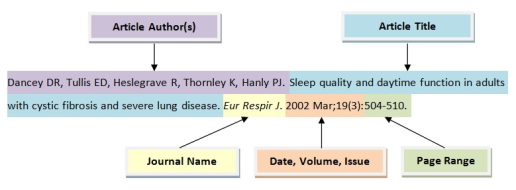|
References often do not get the attention that these important manuscript elements deserve. Scientific and medical journal articles use references to support the authors’ hypotheses, to credit or acknowledge the work of others, and to direct the reader to additional information or resources. The role of the copy editor is to ensure that all references listed are actually cited within the paper, are complete and accurate, and are presented in the correct format and style used by the journal. Frankly, it can be pretty tedious. But, before we explore some time-saving tips, let’s review the basics. Print Journal Articles As per the AMA Manual of Style guidelines, a complete print journal reference should include:
Here are some example print journal article references (recognize any names?):
In this digital age, references are now so much easier to access. Unfortunately, an online presence can be much more transient than print. Links break over time, long uniform resource locators (URLs) are prone to typographical errors (and wreak havoc with typesetting!), and websites can be updated repeatedly so there may be many different versions of the same article. For these reasons, it is important for the author to try to capture all relevant information about an online reference at the time it was accessed. At minimum, this requires the URL and date of access. The sample format is:
Because URLs can break, change, or disappear altogether, many publishers now require more stable identifiers of online material. Two methods are commonly used: the Digital Object Identifier System and the PubMed Identification Number System. A number of journals that I work for use these identifiers to pull references directly and automatically populate the reference list with the correct information in the correct format (such a time saver!). Digital Object Identifier System The DOI System was first launched by the International DOI Foundation in 2000. The goal is to provide an “actionable, interoperable, and persistent” digital network identifier used by publishers and other sectors, such as science data centres and movie studios. In 2012, the DOI System was adopted as the International Standard (ISO 26324). They provide a Digital Identifier of an Object (an object can be any physical, digital, or abstract thing). Over 100 million DOIs have been assigned through a federation of Registration Agencies worldwide with an annual growth rate of 16%. There are 2 elements to a DOI: the prefix and the suffix (separated by a forward slash). All DOIs begin with 10 and are of variable lengths, but they never change once they are assigned. For example, the DOI 10.1183/09031936.02.00088702 for the article listed below begins with “10” like all DOIs, “1183” is the prefix that was assigned by the DOI Registration Agency, and “09031936.02.00088702” is the suffix. Readers can type or paste the DOI name (including the 10 at the beginning and all numbers before and after the slash, but excluding extra characters and sentence punctuation marks) at the DOI website (http://dx.doi.org/). If you have the DOI, you do not have to provide the URL or accessed date in the reference. The DOI appears as the last item in the reference immediately after “doi:” and is set closed up (i.e., no space between):
For journals indexed by PubMed and part of a PubMed citation, a unique PubMed identifier (PMID) is assigned. Readers can enter the PMID in the search box on the PubMed website (http://www.ncbi.nlm.nih.gov/pubmed/) to find the article. The PMID is not usually included in the reference citation like the DOI is, but rather is used as a “behind-the-scenes” identifier or as a link. For example, the PMID for the following article is 10806140 and is used as a link to PubMed website:
Remember that these electronic identification numbers are only identifiers—they do not provide any information regarding quality of the content or the type of paper identified. They are only there to try to locate a specific article or work in an endless sea of digital information. Happy Adventures in Editing!
2 Comments
|
AuthorI am freelance copy editor, proofreader, and instructor based in Toronto. Enjoy my adventures in editing! (Note: I transferred my blog over and lost my comments along the way, unfortunately. Please add new ones.) Archives
October 2017
Categories
All
|

 RSS Feed
RSS Feed